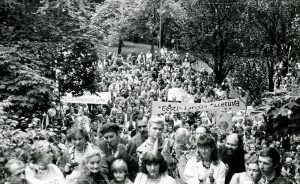Professor Samantha Dieckmann, Somerville’s Tutorial Fellow in Music, explores the relationship between music and emotion, and how both play a central role in conflict and peacebuilding.
Music’s relationship with emotions and capacity to induce them is a double-edged sword. When Wagner’s music was played at Nazi rallies, it drove a sense of ‘ecstatic bonding’ and ‘unity’ in the crowd.
In a politically-charged context, rather than encouraging empathy, music produced an ecstasy of emotions that became antithetical to considering the state of being of others, instead manufacturing a misleading sense of unity where individuals projected emotions onto the collective around them.
But this collective embodiment of musical and emotional encounters can become a powerful tool for peacebuilding too. In the Singing Revolution that swept Estonia in 1987, people in their thousands joined together in singing as a unified expression of resistance to the Soviet regime. Their shared experience both fed into and reflected the feelings communicated in the patriotic folk songs they sang.
My research, conducted with Jane Davidson of the University of Melbourne and published in Music and Arts in Action, explores and defines the capacious term ‘emotion’. The article examines various ways in which the nexus between music and emotion can be understood, the role that emotion plays in making peace, and that emotions lie at the core of a society’s institutional operations.
Peacebuilding and conflict intrinsically involve emotion. From hope, empathy and compassion to fear, anger, solidaristic pride and disgust, Arild Bergh and John Sloboda attest that “emotional work, not strict rational thought, that is the route to reconciliation after civil war.”
Music is also deeply emotional, and has been described as a ‘language of emotion’ or even a ‘grammar of emotion’ for listeners. It is the intergroup trust, social connection and understanding that practical music can encourage that makes it particularly useful. Studies have found, for example, that primary school children who participated in a musical group interaction program had better empathy skills than children who did not. Additionally, this property of music that translates human emotion continues to be realised in practices such as music therapy and community choirs.
But the emotional power of music can be, and historically has been, used for less than altruistic purposes. Music has even been weaponised as a device for violence, humiliation or torture – including notoriously in Guantanamo Bay.
Even projects with positive intentions can be in danger of promoting a ‘salvationist’ narrative where western art music and values are used to save poor or non-western people. Criticisms have been made of the ‘imagined utopia’ of the West-Eastern Divan Orchestra, an ensemble which brings together Israeli and Palestinian musicians, and of a similar narrative present in the Venezuelan ‘El Sistema’ project, which gives poor children free access to musical instruments and tuition.
Collaborative and de-colonial practices must be carefully considered and implemented for peacebuilding or social justice projects to have the most positive impact in the societies and cultures where they are deployed. In the best case scenario, music would help to develop intercultural empathy by celebrating or overcoming an exclusionary definition of difference.
One proposed practice of this is Angela Impey’s suggestion that the truth telling songs of the Muonjieng people, also known as the Dinka, be incorporated into the justice system in South Sudan. The legal court proceedings currently used in the country impose strict hierarchies and roles that do not correspond to the Muonjieng people’s indigenous ways of knowing and understanding the world. The songs contain both reflection and public counsel. They provide catharsis through their deployment of affective language and in their candid descriptions of personal and group suffering, but also function as public testimony of these experiences. In this proposed usage, a communal and indigenous musical ritual could mediate the process of justice and reconciliation for an improved peace outcome.
Emotions work not only to reflect but also to construct the individual and collective subjectivities that produce contexts requiring or pursuing peace. Given the ways in which emotions acquire meaning in, through and as music, peacebuilders are increasingly looking to music as a rich and important resource.

